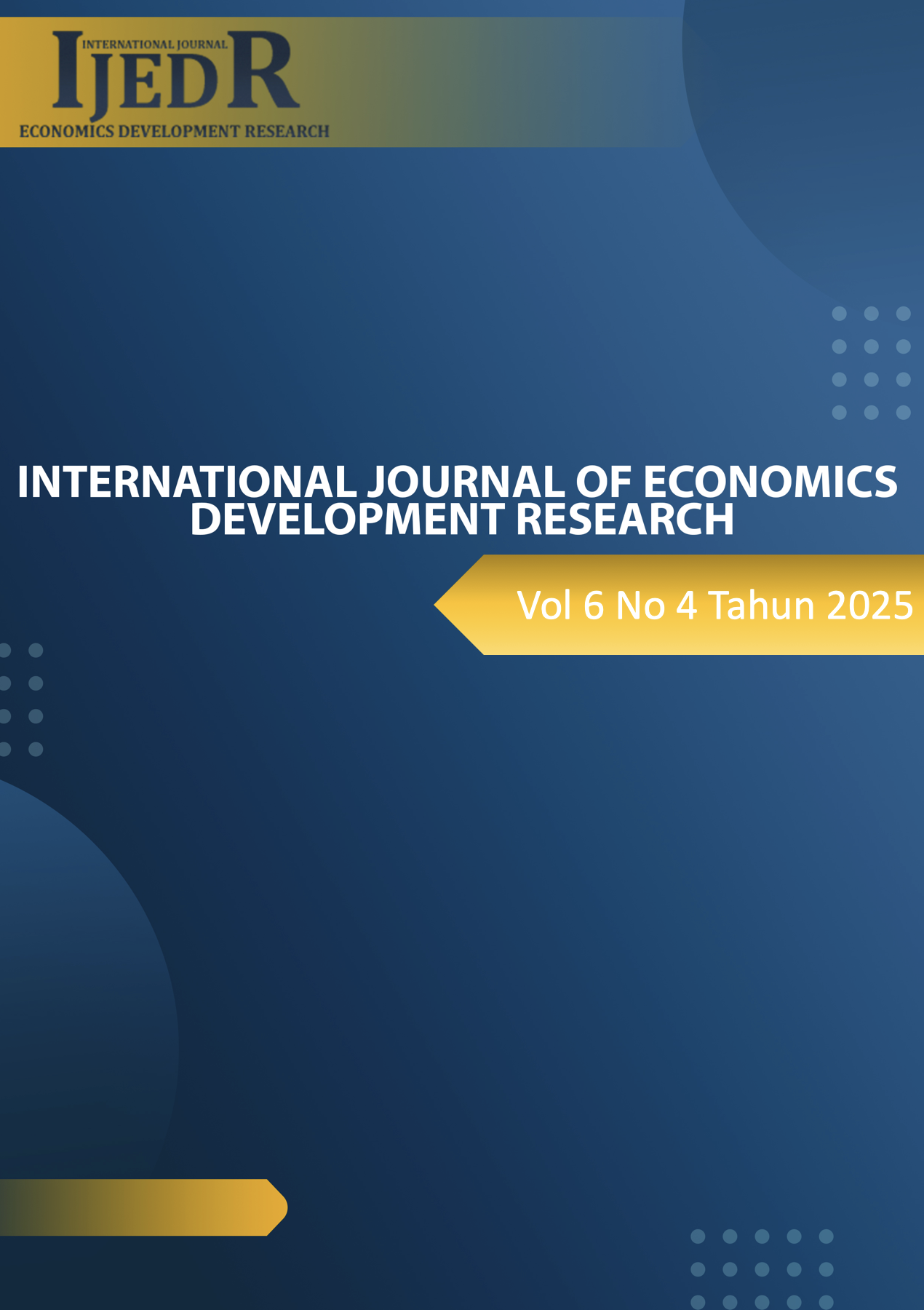Shaping Tourist Preferences and Economic Opportunities: A Case of Attraction and E-WOM at Glamping Alengkong Bali Camp
DOI:
https://doi.org/10.37385/ijedr.v6i4.8515Keywords:
Tourist Attraction, E-WOM, Tourist Preferences, Economic Opportunities, Glamping, Decision to StayAbstract
Bali’s tourism sector has grown rapidly, becoming a key driver of the regional economy. Among its emerging trends is glamping—a form of luxury camping that combines natural immersion with modern comfort. Alengkong Bali Camp is one such destination offering unique outdoor lodging experiences. Tourist preferences in choosing glamping accommodations are influenced by multiple factors, particularly destination attraction and electronic word of mouth (E-WOM). This study aims to examine how tourist attraction and E-WOM shape visitor preferences and indirectly contribute to the economic potential of glamping tourism. The research was conducted at Alengkong Bali Camp using a quantitative descriptive approach and Partial Least Squares Structural Equation Modeling (PLS-SEM) with 112 respondents selected through accidental sampling. The findings reveal that both tourist attraction and E-WOM have a significant and positive effect on tourists’ decisions to stay, indicating their central role in forming visitor preferences. These preferences are critical not only for operational success but also for creating sustained economic opportunities in the local tourism ecosystem. To enhance these effects, glamping managers are encouraged to enrich nature-based activities, improve family-oriented facilities, and strategically promote online reviews to attract potential visitors.
References
Adinegara, G. N. J. (2018). Modeling of tourist satisfaction in Bali. Binus Business Review, 9(3), 261–276. https://doi.org/10.21512/bbr.v9i3.5019
Ardiani, P. I. P., & Sukawati, T. G. R. (2024). The mediating role of customer satisfaction in the relationship between experiential marketing and revisit intention among visitors of Bobocabin Kintamani. International Journal of Economics, Management and Accounting, 2(3), 718. https://doi.org/10.61132/ijema.v2i3.718
Baskoro Harwindito, A., Asmawih, Armand, H. C. K., & Angel, M. (2024). Characteristics analysis of glamping visitors during the COVID-19 pandemic: Case study on Glamping Lakeside Rancabali. International Journal of Travel, Hospitality and Events, 3(1), 11–22. https://doi.org/10.56743/ijothe.v3i1.346
Budiasa, I. M., Suparta, I. K., & Nurjaya, I. W. (2019). Implementation of green tourism concept on glamping tourism in Bali. In Proceedings of the International Conference On Applied Science and Technology 2019, Social Sciences Track(Article 44). Atlantis Press. https://doi.org/10.2991/icastss19.2019.44
Butler, R. W. (1999). Sustainable tourism: A state of the art review. Tourism Geographies, 1(1), 7–25. https://doi.org/10.1080/14616689908721291
Carvache Franco, M., Segarra Oña, M., & Carrascosa López, C. (2019). Segmentation and motivations in ecotourism: The case of a coastal national park. Ocean & Coastal Management. https://doi.org/10.1016/j.ocecoaman.2019.05.014
Carvache Franco, M., Segarra Oña, M., & Carrascosa López, C. (2019a). Segmentation by motivation in ecotourism: Application to protected areas in Guayas, Ecuador. Geojournal of Tourism and Geosites, 24(1), 60–73. https://doi.org/10.30892/gtg.24106-343
Clements, M. A. (1989). Selecting tourist traffic by demarketing. Tourism Management, 10(2), 89–94. https://doi.org/10.1016/0261-5177(89)90048-4
Dedy, A., & Alfandi, Y. (2022). Pengaruh kualitas pelayanan dan fasilitas hotel terhadap kepuasan pelanggan di Sari Ater Hot Springs Resort Ciater. Jurnal Sains Manajemen, 4(1), 18–25. https://doi.org/10.51977/jsm.v4i1.678
Fachlepi, I., Sudiarta, I. N., & Sendra, I. M. (2023). Strategi bauran pemasaran dalam meningkatkan tingkat hunian kamar pada glamping di Taman Danu Camp, Bedugul. Jurnal IPTA (Industri Perjalanan Wisata), 11(2), 92–101. https://doi.org/10.24843/IPTA.2023.v11.i02.p13
Fatwa, A. Z. (2022). Pengaruh harga, promosi, fasilitas, lokasi terhadap keputusan menginap wisatawan. Gastronomía Ecuatoriana y Turismo Local, 1(69), 1–64.
Kerdiati, N. L. K. R. (2024). Integration of green open spaces in tourism accommodation glamping Richland Baturiti Bali. Lekesan: Interdisciplinary Journal of Asia Pacific Arts, 7(1), 16–27. https://doi.org/10.31091/lksn.v7i1.2839
Kristanto, & Wahyuni. (2019). Pengaruh fasilitas dan promosi terhadap keputusan menginap di The Win Hotel Surabaya. Jurnal Ilmu dan Riset Manajemen, 8(2).
Maulidiah, E. P., Survival, S., & Budiantono, B. (2023). Pengaruh fasilitas terhadap kualitas pelayanan serta implikasinya pada kepuasan pelanggan. Jurnal Economina, 2(3), 727–737. https://doi.org/10.55681/economina.v2i3.375
Muhammad, M. H., Hidayanti, I., Abdul Haji, S., & Sabuhari, R. (2025). The influence of tourist experience on revisit decisions with the mediation of tourist satisfaction at Nusliko Park Ecotourism Area. arXiv Preprint. Published June 2025.
Mustofa, M. (2022). Kawasan wisata glamping di lereng Gunung Bismo dengan pendekatan eco-architecture. Journal of Economic, Business and Engineering (JEBE), 4(1), 28.
Nirmalasari, M. D., Pitanatri, P. D. S., & Adinda, C. (2025). An analysis of tourist preferences for luxury resort stays in Bali based on TripAdvisor reviews: A big data perspective. Jurnal Penelitian, 21(2), 1–11. https://doi.org/10.26905/jp.v21i2.15512
Putra, M. Z. D., & Ang, J. F. (2025). Analyzing key factors at glamping Viovio Beach Batam based on customer perspective. Jurnal Pariwisata PaRAMA, 6(1), 67–74. https://doi.org/10.36417/jpp.v6i1.728
Rahjasa, P. S. L., Aspariyanthi, N. L. P. P., & Rahadiarta, I. G. N. P. S. (2023). Generation Z travel planning: Analysis of tourist preferences in adventure tourism in Bali Province. LACULTOUR: Journal of Language and Cultural Tourism, 2(1), 55–59. https://doi.org/10.52352/lacultour.v2i1.1133
Satria Nurcahyo, & Ahmad Ali. (2023). Model peningkatan purchase intention berbasis credibility endorser, eWOM, dan product quality melalui brand image. Jurnal Ilmiah Bisnis, Manajemen dan Akuntansi, 3(1), 35.
Suyasa, N. L. C. P., Susanto, P. C., Mastra, A. S., Indriani, N. L. P., Trihardhini, C. G., & Dewi, N. L. P. W. P. (2021). Karakteristik wisatawan peminat staycation di Kabupaten Badung, Provinsi Bali. Prosiding Sintesa, 4(Maret 2022), 199–208.
Swariga, I. M., Wijaya, N. M. S., & Indrawati, Y. (2024). Influence of motivation on millennial tourist satisfaction and re-visit intention at glamping in Kintamani District, Bangli Regency, Bali. Devotion: Journal of Research and Community Service, 4(8), Article 548. https://doi.org/10.59188/devotion.v4i8.548
Utami, N. K. Y. (2020). Glamping sebagai sebuah perspektif baru dalam akomodasi berkemah. Jurnal Arsitektur Zonasi, 3(3), 185–194. https://doi.org/10.17509/jaz.v3i3.27854
Yogiswari, N. M. M., Suryawardani, I. G. A. O., & Wiranatha, A. S. (2021). The influence of experiential marketing on visitors’ satisfaction and intention to revisit at Batur Camp Bali. Journal of Business on Hospitality and Tourism, 7(1), 180–195. https://doi.org/10.22334/jbhost.v7i1.296





